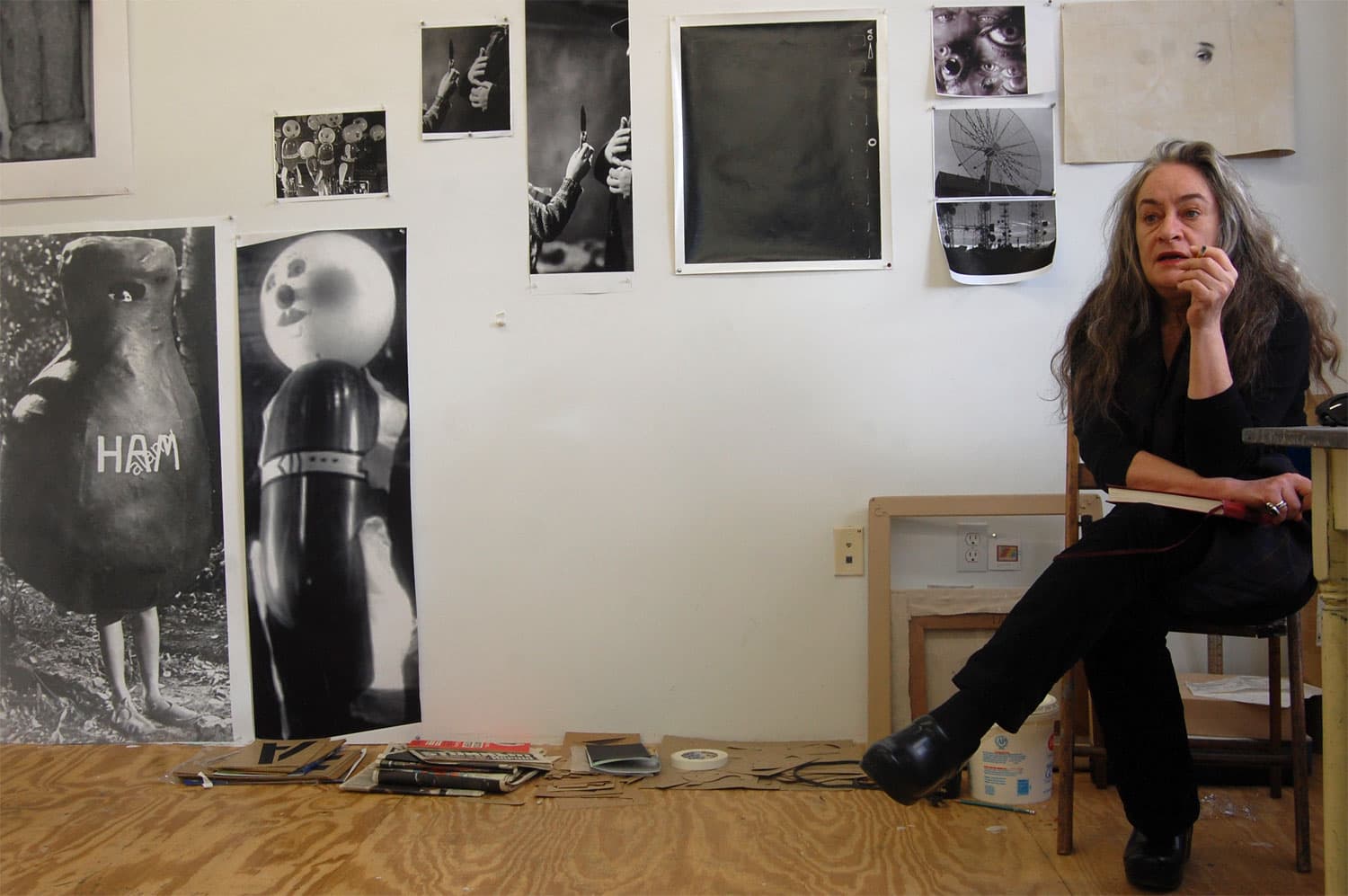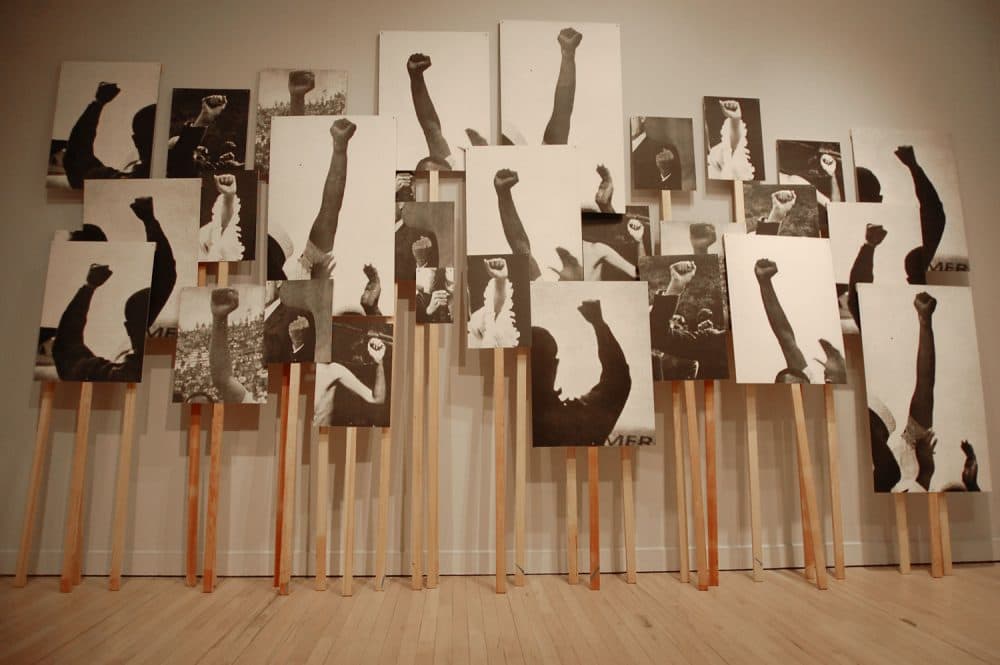Advertisement
Annette Lemieux, Whose Art Addresses History And Politics, Wins MFA’s $10K Prize

“The day after the election, I couldn’t believe he’d won,” Brookline artist Annette Lemieux says of Donald Trump’s victory in the presidential campaign. “I was devastated.”
“I go to Harvard to teach and most of my students are walking in like they were in a dirge,” Lemieux says. Her 1995 artwork “Left, Right, Left, Right” came to mind. It’s a group of signs mounted on sticks leaning against the wall as if waiting for a protest. And each sign is printed with the image of an arm raised in a fist.
“That piece is wrong right now,” Lemieux felt. “It can’t be what it was. I got this idea: I want the piece to be turned upside-down because we all feel deflated and powerless.”
“Left, Right, Left, Right” has been on view at the Whitney Museum of American Art in New York, one of the most prestigious museums in the world. She emailed the institution and asked them to turn her artwork over. Within days, they upended the placards. The museum posted a time-lapse video of the re-installation to Facebook. Which, as of this writing, has been watched more than 23,000 times.
On Tuesday, Boston’s Museum of Fine Arts announced it is awarding Lemieux its $10,000 Maud Morgan Prize, which the museum says honors “a Massachusetts woman artist who has demonstrated creativity and vision, and who has made significant contributions to the contemporary arts landscape.” In addition to the financial award, the museum plans to present an exhibition of her work in July 2017.
“She’s looked at archetypical images from art — 20th century art history, but also film — and edited them and tweaked them to give them new meaning, whether that’s cheeky or critical,” says Al Miner, the museum’s assistant curator of contemporary art, who will be working with Lemieux on her MFA show. “She’s always taking something from the world and turning it on its head to give it new meaning.”
Lemieux has stacked books so that their titles could be read one after the other as a sort of poem. The MFA owns her 1988 painting “Pacing,” in which she made a dark line nearly 15 feet long by pacing back and forth with her feet wet with paint. She’s branded (literally) the accounts of Holocaust survivors into 12-foot image she called “Hell Text.” She’s riffed on modern art — having herself photographed like Philip Guston’s painting of himself huddled in bed and Man Ray’s photo of a woman smoking a cigarette. Lemieux has attached little wheels and headlamps to 18 military helmets and set them on the floor like a strange searching army. After the Sept. 11 attacks, she made what she called “comfort art,” including a circular pillow as wide as she is tall. She has dubbed a row of three plaster balls “Reclining Snowman.” She has made a faux hay bale by screenprinting a rectangular box with an image of hay.
Advertisement
“The work has always been politically engaged. It’s humanistic. It’s about me and the world,” Lemieux says. “But maybe it’s about us and the world. Because we all have similar experiences.”
Lemieux grew up in Connecticut and enrolled at Hartford School of Art in the late 1970s, where she studied with David Salle and Jack Goldstein, who would become two of the most prominent New York post-modern painters. When she moved to New York herself, in 1981, she worked for a time as an assistant to each man. And she got introduced into the circle of New York post-modern artists including Sherrie Levine, Robert Longo, Richard Prince and Cindy Sherman, who ended up in the history books. They often appropriated existing paintings or photos that they copied or remixed, or made new artworks that evoked, say, the look of old B-movie stills.
The experience seems to have resonated deeply with Lemieux, whose art is often similarly based on secondhand imagery and has a cool, detached affect. But she separates her own efforts from what that post-modern group was up to. “My work didn’t so much deal with issues of contemporary media,” Lemieux said in a 2005 interview. “A lot of it was … autobiographical, but without telling a story.”

The meanings of her art can be coded and slippery. The photos she copied onto the placards for “Left, Right, Left, Right” include the fists of Martin Luther King Jr., Richard Nixon, Jane Fonda, Miss America and more anonymous folks. The intent of their raised hands differs, even representing opposing political stances, if they even symbolize a political stance at all. So what at first glance can appear to be a protest kit waiting for action, seems rather to be an artwork mulling the nature of activism, questioning it, perhaps doubting it.
Lemieux began living around Boston part-time in the late 1980s and moved here full-time around ’92. In her studio in Boston’s Allston neighborhood, she’s working on pieces for her MFA exhibition. Tacked to the white walls are photos from Fritz Lang’s 1931 film “M” about a serial murderer of children and the 1962 film version of Harper Lee’s novel “To Kill a Mockingbird,” with Gregory Peck as the Alabama lawyer Atticus Finch, who defends an innocent black man against racist accusations that he raped a white woman.
In particular, Lemieux is focused on the balloon the murder uses to lure a victim in “M” and the small, carved portraits of Finch’s children the mysterious “Boo” Radley leaves for them in a hole in a tree in “Mockingbird.” She’s thinking of carving copies of the sculptures, but 47-inches tall, the height of an average girl. She might commission a latex balloon the same height and have the sculpture of the girl hold the balloon.
She’s thinking of these threatened girls, and the home Finch made for his children — a “haven,” Lemieux calls it — and toying with the phrase “Area of Refuge.”
“There is a darkness in the images because I think the times are kind of dark. There is humor in my work, but it’s always kind of dark,” Lemieux says. “…The images in the end maybe have to do collectively with violence and the idea of utopia and threats. At the same time, though I’m attracted to things, you don’t know why you’re attracted to them.”
